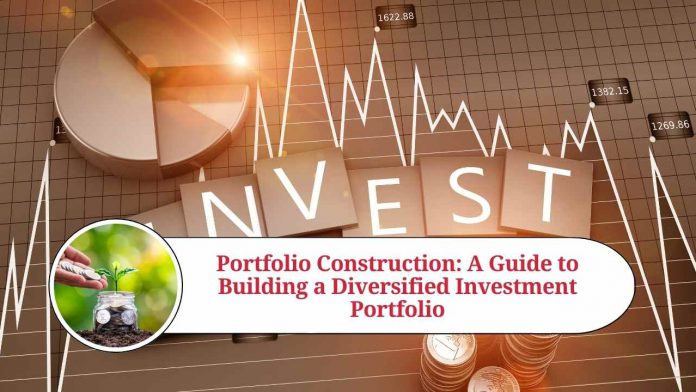Portfolio Construction: A Comprehensive Guide
Portfolio construction is the process of selecting a set of assets that aligns with an investor’s financial goals, risk tolerance, and investment horizon. The goal of portfolio construction is to create a diversified portfolio that maximizes returns while minimizing risks. In this article, we will explore the various steps involved in portfolio construction and the factors that need to be considered while constructing a portfolio.
Step 1: Defining Investment Objectives
The first step in portfolio construction is to define investment objectives. Investors need to have a clear idea of what they want to achieve with their investments. This can be anything from generating income to capital growth, capital preservation, or a combination of all three. Defining investment objectives is essential because it helps investors determine the appropriate asset allocation and risk tolerance for their portfolio.
Step 2: Asset Allocation
Asset allocation is the process of dividing an investment portfolio among different asset classes such as stocks, bonds, commodities, and real estate. Asset allocation is crucial because it helps investors manage risks and achieve their investment objectives. The optimal asset allocation will depend on an investor’s investment objectives, risk tolerance, and investment horizon.
Step 3: Security Selection
Security selection involves choosing individual securities within each asset class. Investors need to consider various factors such as financial performance, industry trends, and the overall economic environment while selecting securities. It is essential to diversify within each asset class to minimize risks.
Step 4: Portfolio Optimization
Portfolio optimization involves using mathematical models to select the most efficient portfolio based on an investor’s investment objectives and risk tolerance. Portfolio optimization takes into account various factors such as expected returns, risks, and correlations between different assets.
Step 5: Risk Management
Risk management is an essential part of portfolio construction. Investors need to identify and manage risks associated with their investments. Diversification is one of the most effective risk management strategies. By diversifying their portfolio across different asset classes and securities, investors can reduce the overall risk of their portfolio.
Step 6: Regular Review and Rebalancing
Portfolio construction is an ongoing process. Investors need to regularly review their portfolio to ensure that it continues to align with their investment objectives and risk tolerance. Rebalancing involves adjusting the portfolio’s asset allocation to maintain the desired risk and return profile.
Portfolio construction is a critical aspect of investing. A well-constructed portfolio can help investors achieve their financial goals while minimizing risks. In contrast, a poorly constructed portfolio can result in significant losses and missed opportunities. Therefore, investors need to understand the various factors that impact portfolio construction to make informed investment decisions.
One of the key factors that investors need to consider while constructing a portfolio is their investment objectives. Investors need to have a clear idea of what they want to achieve with their investments, such as generating income, capital growth, or a combination of both. This will help them determine the appropriate asset allocation and risk tolerance for their portfolio.
Asset allocation is another critical aspect of portfolio construction. The optimal asset allocation will depend on an investor’s investment objectives, risk tolerance, and investment horizon. Asset allocation is crucial because it helps investors manage risks and achieve their investment objectives. It is essential to diversify within each asset class to minimize risks.
Security selection is another important aspect of portfolio construction. Investors need to choose individual securities within each asset class based on various factors such as financial performance, industry trends, and the overall economic environment. It is essential to diversify within each asset class to minimize risks.
Portfolio optimization is another critical aspect of portfolio construction. Portfolio optimization involves using mathematical models to select the most efficient portfolio based on an investor’s investment objectives and risk tolerance. Portfolio optimization takes into account various factors such as expected returns, risks, and correlations between different assets.
Risk management is also an essential part of portfolio construction. Investors need to identify and manage risks associated with their investments. Diversification is one of the most effective risk management strategies. By diversifying their portfolio across different asset classes and securities, investors can reduce the overall risk of their portfolio.
Finally, regular review and rebalancing are critical to ensuring that the portfolio continues to align with an investor’s goals and risk tolerance. Market conditions and an investor’s financial situation can change over time, and their portfolio needs to reflect these changes.
Conclusion
In conclusion, portfolio construction is a complex process that requires careful consideration of an investor’s investment objectives, risk tolerance, and investment horizon. By following the steps outlined above, investors can construct a diversified portfolio that aligns with their investment goals and helps them achieve their long-term financial objectives. Regular review and rebalancing are critical to ensuring that the portfolio continues to align with an investor’s goals and risk tolerance.
Read more useful content:
Frequently Asked Questions (FAQs)
What is portfolio construction?
Portfolio construction is the process of selecting a set of assets that aligns with an investor’s financial goals, risk tolerance, and investment horizon.
Why is portfolio construction important?
Portfolio construction is essential because it helps investors manage risks and achieve their investment objectives. A well-constructed portfolio can help investors achieve their financial goals while minimizing risks.
What factors should I consider while constructing a portfolio?
Investors need to consider various factors such as their investment objectives, risk tolerance, investment horizon, asset allocation, security selection, portfolio optimization, and risk management while constructing a portfolio.
What is asset allocation?
Asset allocation is the process of dividing an investment portfolio among different asset classes such as stocks, bonds, commodities, and real estate.
What is security selection?
Security selection involves choosing individual securities within each asset class based on various factors such as financial performance, industry trends, and the overall economic environment.
What is portfolio optimization?
Portfolio optimization involves using mathematical models to select the most efficient portfolio based on an investor’s investment objectives and risk tolerance. Portfolio optimization takes into account various factors such as expected returns, risks, and correlations between different assets.
What is risk management?
Risk management is an essential part of portfolio construction. Investors need to identify and manage risks associated with their investments. Diversification is one of the most effective risk management strategies.
How often should I review and rebalance my portfolio?
Regular review and rebalancing are critical to ensuring that the portfolio continues to align with an investor’s goals and risk tolerance. It is generally recommended to review and rebalance the portfolio at least once a year.
How can I diversify my portfolio?
Diversification involves investing in different asset classes and securities. By diversifying their portfolio, investors can reduce the overall risk of their portfolio.
How do I determine my risk tolerance?
Risk tolerance refers to an investor’s willingness to take on risk. Investors need to consider various factors such as their age, financial situation, and investment goals to determine their risk tolerance. It is essential to select investments that align with an investor’s risk tolerance to minimize risks.




















